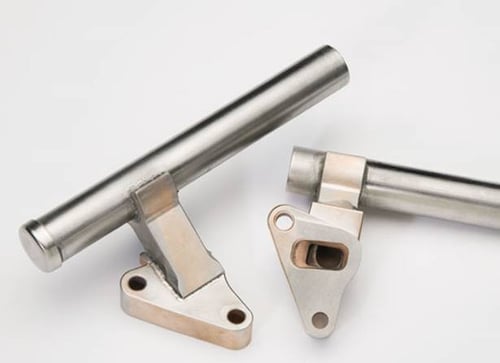Many people working with small components have heard the term “near net shape” thrown around. This term refers to when a vendor can, with its primary process, manufacture a result close to the final size and shape your plans called for. That means the part requires minimal machining or other secondary processes afterward.
But what if you could drop the “almost” and create a truly net shape component with powdered metal? You can!
Maybe you’ve already had some of the potential benefits pop in your head. Here are some of the biggest, along with a definition of what powder metal experts consider net shaping capability.
What’s a Net Shape Part?
With powder metallurgy, you identify your powder of choice and your vendor pours it into the die, which is shaped as the mirror image of your design. Since you can control where you put the powder and how much, when it’s compacted it turns out exactly how you want the final version to look.
The part will still need sintering and, occasionally, some other fine tuning like drilling holes. Nonetheless, you can -- with minimal or no machining -- benefit from a process that goes directly from sintering/pressing to final use!
On to those benefits:
Advantages of Net Shaping Capability
1. Waste
The more raw resources your vendor needs, the more it’s going to affect your bill.
If an engineer starts with a bar of steel and machines a gear from it, the gear may only use 60% of the original bar. The rest is on the floor as waste (called turnings in the powder metal industry).
Powder metallurgy can make you that same gear with zero waste (or at most a few percentage points).
The making of modern transmission carriers is a prime example of a wasteful process. Even with casting, your manufacturer has to throw away a lot of material to achieve the final result.
Not with a precise powder metal process like sinter-brazing!
2. Turnaround Time
Not only are you wasting material with machining away all that excess material, you’re also wasting time. Powder metal’s net shaping ability can speed up your supply chain and lead times.
3. Production & Labor Costs
The shorter the processing time, the less you’ll fork over for production and labor costs. Having your components practically market-ready after the first process cuts costly finishing from your manufacturing run. You won’t have to pay for someone to run all those secondary process, plus the machines to help him do it.
4. Combined Shapes
There are certain geometries you can achieve with a single powder metal net-shaped part that would require multiple operations if you used machining instead.
Need a big gear on top and a small gear on the bottom. Powder metallurgy can handle that in a single process thanks to its shape-combining ability.
With powder metal you can add a hub or other features to your part -- it doesn’t have to be a simple round shape or a gear. Multipiece assemblies can be made as a single part without the need to weld, braze, or stake the additional parts. This same reduction in pieces is very apparent in soft magnetic composite parts, where you can often reduce the number of components from 1,300 pieces to under 10.
While less dramatic, transmission carriers are again a good example of a product that can be streamlined with sinter bonding or brazing net-shaped parts. Your manufacturer can make the top and lower sections separately, then braze them together
 At Horizon, for the tube assembly pictured above, the stainless tubing and two copper-infiltrated powdered metal parts are all brazed together. When we say infiltration, we mean melting copper into the part to fill the porosity.
At Horizon, for the tube assembly pictured above, the stainless tubing and two copper-infiltrated powdered metal parts are all brazed together. When we say infiltration, we mean melting copper into the part to fill the porosity.
New Possibilities With PM
There’s no need to start your project with that depressing thought of “How much material am I paying for that’s going to get thrown away?” Instead, with the right powder metal process, you can be thinking of the endless design and cost-cutting possibilities you’ve opened up.
There’s a reason 65-70% of the powder metal industry’s output is non-machined parts. It’s simply more cost-efficient. It’s also why nearly all of what Horizon produces is non-machined -- more than 90%!
Plus, by combining shape-making with advanced compaction and ultra-high-temperature sintering, you can open up a lot of doors, particularly in the automotive industry:
Watch the video on Youtube here.
To see the additional design benefits of powder metal, check out these resources:
- What Is Soft Magnetic Composite?
- Soft Magnetic Composite Vs. Lamination Steel: Uses & Limitations
- Introducing 1P, 3P & 5P: Powder Metal Materials Optimized at Last



